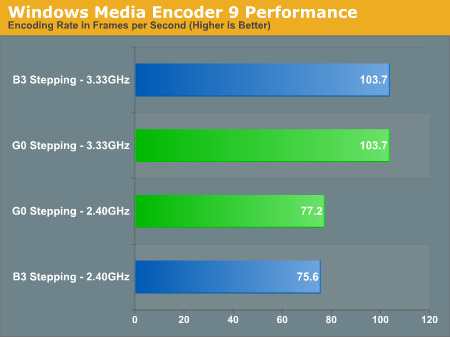Intel Core 2 Q6600 G0 Stepping: Cheap Quad Core Just Got Better
by Anand Lal Shimpi on August 16, 2007 11:53 AM EST- Posted in
- CPUs
Performance
We know the new stepping uses less power than its predecessor, and overclocks a little better, but do any of the errata fixes result in a performance increase? To find out we ran two benchmarks: our Windows Media Encoder 9 test and our Cinebench 9.5 benchmark. We ran the tests at both stock and overclocked speeds, the results are below:

There are very slight differences in performance but nothing that falls out of the range of normal variation between tests.

This sort of insignificant performance difference between steppings is to be expected, no surprises here.
Final Words
Power consumption of the new G0 cores is not only better than their predecessors, but it seems to scale better with clock speed. As we overclocked our Q6600s total system power consumption increased at a slightly lower rate with the new G0 stepping than with the previous B3 cores. The power savings aren't tremendous, we're talking on the order of 3 - 6% depending on clock speed, but it is a measurable improvement.
The impact on overclocking is a little less clear, at least with the quad-core Q6600. We were able to reach a higher maximum overclock with the SLACR stepping Q6600, but our highest stable overclock was not that much more than our original B3 stepping. If we look at percentages, our G0 part managed a 3 - 6% better overclock, putting overclocking potential in line with the power savings we noted. It's not a tremendously better overclocker but we suspect that on a whole it will yield tangible benefits.
There's no doubt that the new G0 stepping cores represent the latest improvements in the Core 2 lineup, but it's worthwhile to keep expectations in line with reality. If you're looking for a huge change in power consumption/overclocking headroom, you may have to wait for Intel's 45nm Penryn cores.










34 Comments
View All Comments
gigahertz20 - Thursday, August 16, 2007 - link
Anand,Your overclocking results mean nothing if you don't list what type of cooling you used? Stock Intel cooler? Tuniq Tower 120? Thermalright Ultra-120 Extreme? Typhoon VX? Zalamn? Scythe? Noctua? The only thing you said was "our max was 3.51GHz (390 x 9.0) without resorting to improved cooling" so by that statement I'm assuming you must have been using air but which HSF?
How can you miss this? Indians aren't supposed to make mistakes, just kidding :) We're all human.....at least I think :)
Anand Lal Shimpi - Thursday, August 16, 2007 - link
Sorry, I thought I mentioned that I was using the stock Intel HSF. :)Take care,
Anand
Roy2001 - Friday, August 17, 2007 - link
Could you try a better HSF? ATers whwant to OC this beast would avoid stock HSF I believe.Omega215D - Thursday, August 16, 2007 - link
He was just being a SLACR...:ducks:
vijay333 - Thursday, August 16, 2007 - link
Could you also comment on whether there were any noticeable differences between the CPUs with regards to temps? Kinda related to the wattage of course, but actual idle/load temperature values would help too. Thanks.aka1nas - Thursday, August 16, 2007 - link
I didn't see listed which board was used to test overclockability of the two chips. Lots of boards still have issues with clocking G0s to high FSB speeds, especially at a 9x multi as the previous poster mentioned.Anand Lal Shimpi - Thursday, August 16, 2007 - link
Sorry, I updated the article with the test table. I used the Gigabyte GA-P35C-DS3R.Take care,
Anand
ChronoReverse - Thursday, August 16, 2007 - link
I have two G0's and it seems there's a great deal of variation even for two CPUs in the same batch.You should check the VID (using Core Temp) of the CPU. A lower VID means Intel rated the CPU to run at stock with a lower voltage, generally meaning more overclocking headroom. Of my two G0 Q6600's, one was 1.3125V while the other was 1.2750V.
Also, the 9X multiplier is harder to overclock on than lower multipliers (for reasons unknown to me but I've encountered it myself as well as read other people commenting thus). My 1.3125V Q6600 can boot and run at 3.6GHz (450x8) almost stably (it can Prime95 all four cores for at least 20 minutes) but trying to do the same at 400x9 will always fail. I know that 400MHz FSB works since I can boot at 400x8, so I'm assuming the other factor would be the multiplier.
Dainas - Saturday, August 18, 2007 - link
Would it be possible to get a VID of 0.8250v? As that it what Core Temp reads for my G0 Q6600, but I have doubts as the the accuracy as I'm x64 Vista and Core temp cannot find the temps (the rest of the read stats check out though).Also CPU-z reads its default Voltage as being around 1.18v.
Darkmatterx76 - Thursday, August 16, 2007 - link
Since OC potential varies so much with these CPU's are there any companies that test the CPU's they buy from Intel/AMD and sort them based on the OC potential they have? Memory companies often test and sort their memory and package them according to their quality. It would be nice to get a CPU that's been tested for better then average OC potential without having to pay $1000 for an Extreme brand CPU. I wouldn't mind paying a little bit more for a Q6600 that I knew had some good OC room.